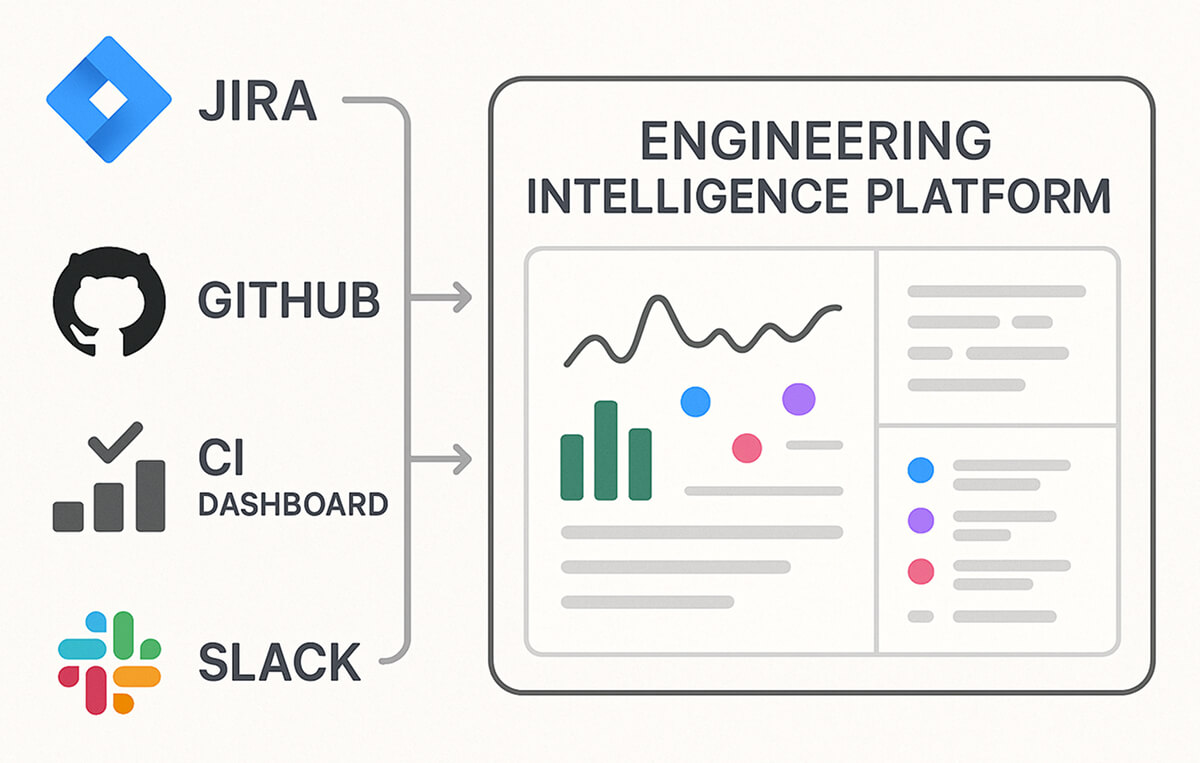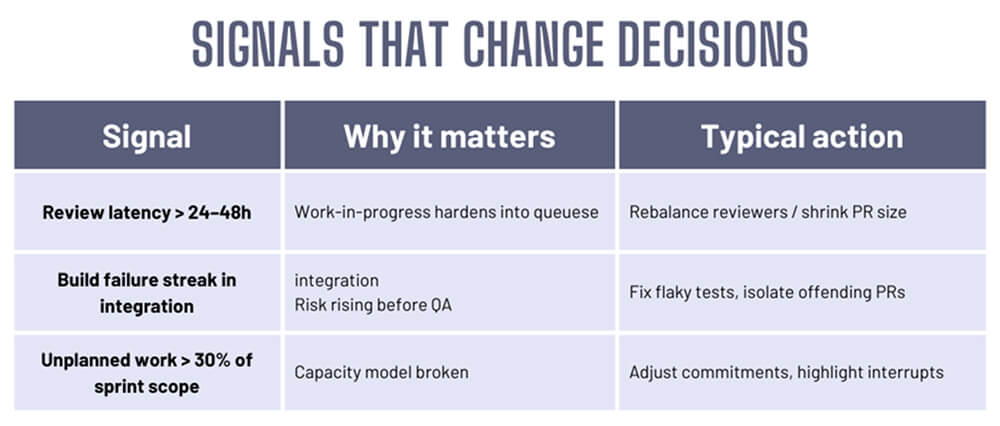Modern agile development seems like something completely different from what it was five or ten years ago. The size of systems, intricate pipelines, shorter release cycles, time-zone differences, and the number of languages can complicate and escalate stress in a very short timeframe.
Simply relying on gut feel or a couple of sprint charts no longer gives leaders what they need. Developers want specific feedback on where work is stalling, how quality is trending, and whether the delivery path is healthy.
This is where software engineering intelligence platforms (SEIPs) or engineering management software come in. These systems pull data from all your dev tools, show what’s flowing and what’s blocked, and give teams the insight to fix issues quickly and ship with confidence.
What Are Engineering Intelligence Platforms?

Engineering intelligence platforms integrate seamlessly with existing tools, such as Jira, GitHub, CI dashboards, and Slack, to provide a unified interface for their data.
Now, instead of jumping between tools trying to figure out what work progress looks like, everyone can see what progress has actually been made, which pull requests are stuck, which tests keep failing, and where the pipeline bottlenecks are.
- For developers, they answer everyday questions in seconds.
- For managers, they shift focus from counting tasks to understanding real impact, what’s shipping, what’s blocked, and how quality is trending.
Core capabilities you’ll find across mature platforms
- Productivity & flow: SEIPs track cycle time, lead time, review latency, and deployment frequency. This shows how quickly ideas turn into shipped code and pinpoints slow steps in the pipeline.
- Code health: They track defect trends, hotspots, refactor activity, and test coverage gaps. They also highlight fragile areas and technical debt before they cause outages.
- Bottleneck detection: They track slow reviews, flaky tests, capacity mismatches, and environment waits. This helps identify the single point that’s throttling delivery, so teams can address it first.
- Team health indicators: They track workload balance, after-hours patterns, and sustainable pace. This flag burns out risk early and helps managers maintain a sustainable pace.
- Forecasting: They use past delivery data to project realistic completion dates and surface timeline risks.
How SEIPs differ from traditional trackers
Traditional project trackers show plans and tickets—in other words, they tell you what should happen. However, SEIPs demonstrate flow and outcomes, showing what actually happens once code execution begins.
That distinction matters because Agile is ultimately about enabling a steady, predictable flow of value, not just managing a list.
Why They Matter for Agile Teams in 2025
1. Data-Driven Decision Making
- Live sprint health: Dashboards stream cycle time, flow efficiency, and team capacity, so problems appear the day they start.
- Early risk alerts: Spikes in review wait time, test failures, or blocked stories trigger notifications. This allows you to identify and resolve bottlenecks before they derail the sprint.
- Shift from reactive to proactive: Instead of scrambling after a slip, teams reassign reviewers or rebalance work the moment a metric crosses a threshold.
- One source of truth: Everyone sees the same numbers. This reduces bias and “loudest-voice” decisions.

2. Improved Productivity and Flow
- See hidden delays: Tracks cycle time, lead time, and deploy frequency so you spot slow PR reviews, queued test environments, and paused releases.
- Automatic nudges: Flags patterns like “PRs wait 48 h for first review” and pings the right people.
- Data-driven fixes: Teams switch to smaller PRs, schedule review hours, and trim brittle end-to-end tests, reducing thrash, cognitive load, and Friday rollbacks.
3. Enhanced Collaboration and Transparency
- Shared dashboards: Product, engineering, and leadership all view the same live data, eliminating the need for extra status meetings.
- Single narrative: Progress and risk are visible, so devs don’t “sell” progress, and PMs stop chasing updates.
4. Quality and Risk Management
- Always-on monitoring: SEIPs track change-failure rates, defect spikes, and incident recovery times the moment they occur.
- Early intervention: They flag rising risks before they snowball, allowing teams to patch the weak module or improve tests right away.
- Timeline realism: Forecasts indicate how today’s risk trend could delay the release date, potentially preventing last-minute heroics.
5. Supporting Distributed and Hybrid Teams
- One shared lens: Everyone in the team views the same dashboards and definitions, avoiding regional drift.
- Standardized habits: SEIPs promote common rules, such as what counts as “review done,” which tests gate a merge, and when after-hours work is acceptable.
- Smooth hand-offs: Consistent visibility ensures async stand-ups and cross-continent hand-offs run smoothly without guesswork.
6. Aligning Engineering with Business Goals
- Translate flow to value:
- Faster cycle time ⇒ Shorter time-to-market
- Higher stability ⇒ Happier customers
- Sustainable pace ⇒ Better retention.
- Data-driven prioritization: When every metric maps to outcomes that leadership already tracks, trade-off decisions become easier and trust increases.
Best Practices for Agile Teams Using SEIPs
Focus on the few metrics that move the needle
- Use battle-tested metrics like DORA (deploy frequency, lead time, change-failure rate, MTTR) and SPACE (satisfaction, performance, activity, communication, efficiency).
- Skip vanity numbers like lines of code and commits per day, because they reward motion, not outcomes.
- Revisit the list every quarter; as the team matures, the “critical four or five” will change.
Surface insights where the work already happens
- Show review-latency badges right inside GitHub or GitLab PRs.
- Connect risk alerts to the team’s Slack or Teams channel.
- Embed test-flakiness trends in the CI/CD dashboard so no one has to hunt for them.
- Contextual metrics = higher adoption and faster action.
Lead with transparency and trust
- Share dashboards with the team first, then with leadership.
- Work with the entire team to determine which charts will be displayed and what each one represents.
- Make it clear that the goal is improvement, not surveillance or individual scorekeeping.
Evolve the framework as you scale
- Small teams focus on raw delivery speed, while big orgs focus on how all those deliveries intersect without causing chaos.
- Retire charts that no longer drive decisions. Add new ones as priorities shift.
- Treat the measurement framework itself as a living product; iterate, prune, and grow with the organization.
Challenges to Anticipate
- Metric misreads: A chart never tells the whole story. A drop in velocity might mean lost productivity, or it might simply mean the team focused on paying down technical debt. Without context, it’s easy to draw the wrong conclusion.
- Chasing numbers instead of outcomes: When a metric is visible, teams naturally try to improve it. That’s good, until the metric itself becomes the goal. For example, optimizing cycle time without watching quality can lead to rushed reviews and unstable releases.
- Privacy and trust concerns: If dashboards look like surveillance, developers will feel watched instead of supported. This erodes trust quickly. Platforms should be framed as tools for learning, not scorekeeping, with most insights kept at the team level.
- Adoption costs: Even with strong integrations, rolling out a new system takes time and attention. Teams already under pressure may see it as just another burden. Starting small, focusing on one team or a single set of metrics, helps ease the transition.
- Balancing autonomy with measurement: Agile relies on ownership and creativity. Too much focus on dashboards can reduce engineering to chasing targets. The best use of SEIPs is to guide improvement, not dictate it.
FAQ
1. How do these platforms actually support Agile decision-making?
They provide a current snapshot of flow and risk so you can adjust mid-sprint, reassign reviews, split a risky epic, or change scope based on evidence.
2. What features should we expect from a developer experience platform?
Tight integrations, flow and quality metrics, trend-based forecasting, and readable dashboards for both engineers and product. Many tools also collect lightweight feedback so you can compare delivery data with how the team actually feels.
3. Will it work with our existing tools like Jira or Git?
Yes. Modern platforms plug into Jira, GitHub/GitLab/Bitbucket, CI/CD, and incident systems with minimal setup. Good ones also expose APIs for custom pipelines.
4. Which metrics should we track to show impact?
Start with DORA for delivery and a small slice of SPACE for well-being and collaboration. Resist activity tallies, such as PR count per engineer, since they rarely correlate with outcomes that the business cares about.
Conclusion
Agile practices thrive when teams can see the real state of delivery, not just the plan. SEIPs make that state visible. Engineering-intelligence platforms extract data from your tools and consolidate it into a single, clear picture of flow, quality, and risk that both developers and leaders can understand.
Used correctly, SEIPs increase productivity while avoiding burnout, enhance cooperation without extra meetings, and connect engineering success to business outcomes. In 2025, that isn’t optional; it’s how contemporary software teams remain competitive.

